Still to be finished and painted, here’s my backhoe dolly for the BH77 used behind my B2650. It’s been in the unfinished “prototype” version waiting for any changes for a number of years. No changes needed so now I just need to finish some welds and finally get it painted…. one day.
But with some recent questions about backhoe dollies….thought I’d post these pics now…..maybe they’ll be of interest to someone.
It's made from 2”x2” sq. tubing for the long sides atop 2”x3” rectangular tubing for the end cross pieces and heavy duty wheel supports.
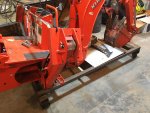
With the BH77 mounted on the tractor the dolly slides underneath until the vertical guide posts butt up against the hoe’s metal framework as shown in the pics. I had to notch out the top of the dolly's front support/rest for clearance when sliding it under the main framework of the backhoe. I think I’ll cut that center section out completely when finishing the welds for final painting. But for now it works great as is.
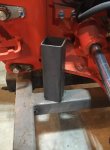

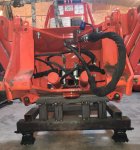
With the hoe unpinned, clear of the tractor, and ready to be lowered onto the dolly…..the guideposts help keep things centered and lined up for lowering the hoe down and onto the main support tubes.
The dolly’s bucket end is made to support the main boom's framework with the bucket resting against the angle iron cross piece as shown.
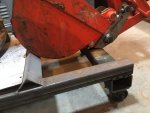
With the main support at the right height, the hoe sits at the right angle to be rolled up to the tractor and slip into the backhoe's lower mounting arms. Using the hoe's hydraulics, it’s rotated up into position to pin the top bracket locations in place. At rest on the dolly, there is no pressure or weight on any of the cylinders. A ratchet strap across the raised outriggers prevents them from sagging as well.

I added a middle support cross piece (1” sq tubing) to prevent the hoe from sagging downward with any slow hydraulic fluid leakage. (You can see this white sq. tube in the first pic for a better overall view).
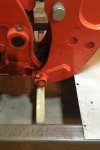
Once the backhoe is mounted with the outriggers down for support…..the boom/bucket is raised up off the dolly allowing it to be slid out from underneath.
Up next in a couple of years....maybe: "I finally finished and painted my backhoe dolly!!"
But with some recent questions about backhoe dollies….thought I’d post these pics now…..maybe they’ll be of interest to someone.
It's made from 2”x2” sq. tubing for the long sides atop 2”x3” rectangular tubing for the end cross pieces and heavy duty wheel supports.

With the BH77 mounted on the tractor the dolly slides underneath until the vertical guide posts butt up against the hoe’s metal framework as shown in the pics. I had to notch out the top of the dolly's front support/rest for clearance when sliding it under the main framework of the backhoe. I think I’ll cut that center section out completely when finishing the welds for final painting. But for now it works great as is.



With the hoe unpinned, clear of the tractor, and ready to be lowered onto the dolly…..the guideposts help keep things centered and lined up for lowering the hoe down and onto the main support tubes.
The dolly’s bucket end is made to support the main boom's framework with the bucket resting against the angle iron cross piece as shown.

With the main support at the right height, the hoe sits at the right angle to be rolled up to the tractor and slip into the backhoe's lower mounting arms. Using the hoe's hydraulics, it’s rotated up into position to pin the top bracket locations in place. At rest on the dolly, there is no pressure or weight on any of the cylinders. A ratchet strap across the raised outriggers prevents them from sagging as well.

I added a middle support cross piece (1” sq tubing) to prevent the hoe from sagging downward with any slow hydraulic fluid leakage. (You can see this white sq. tube in the first pic for a better overall view).

Once the backhoe is mounted with the outriggers down for support…..the boom/bucket is raised up off the dolly allowing it to be slid out from underneath.
Up next in a couple of years....maybe: "I finally finished and painted my backhoe dolly!!"

